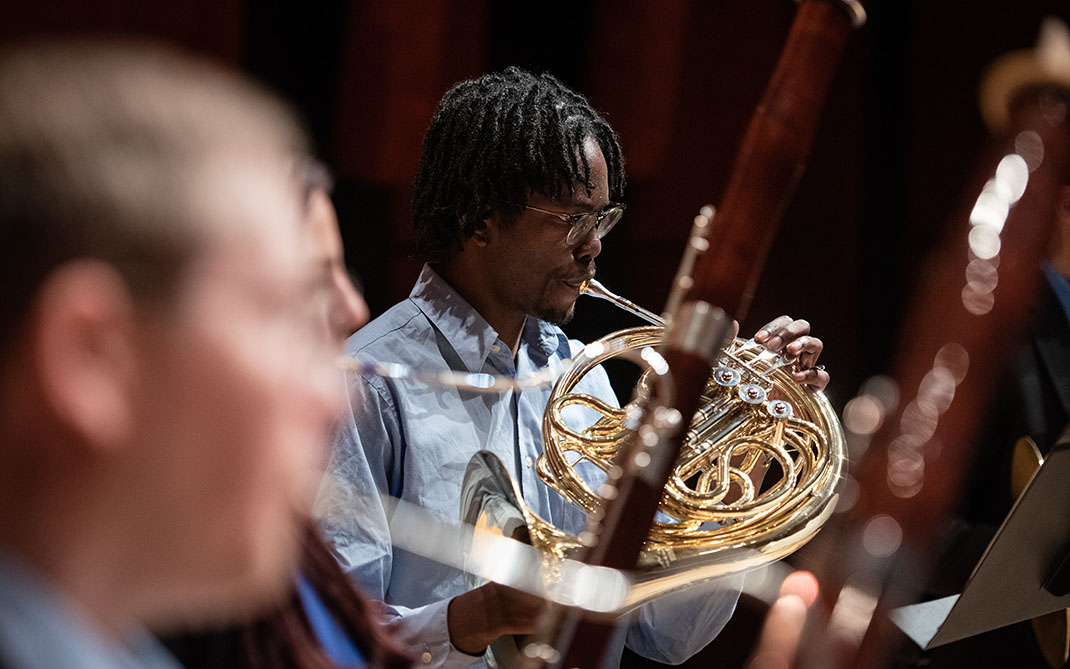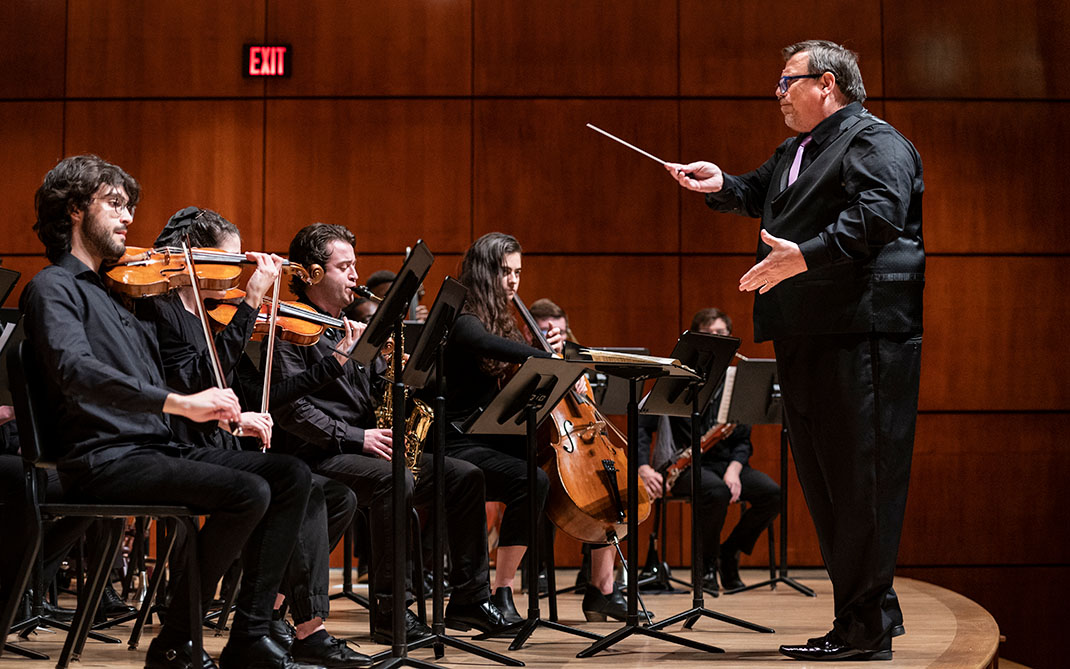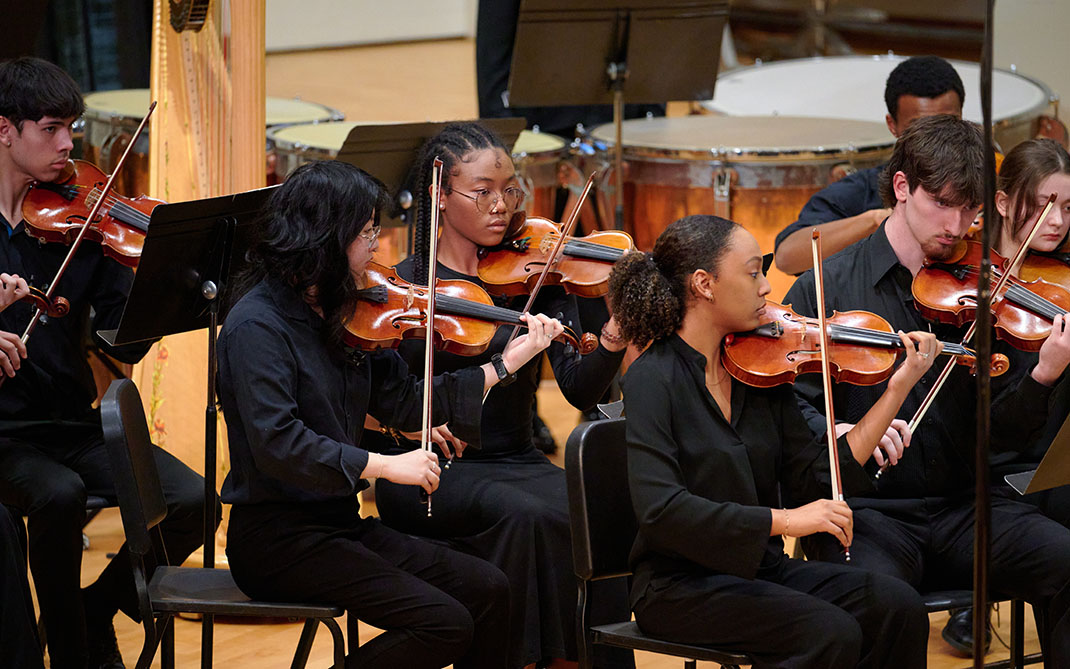Equal Opportunity Policy 111
| Policy 111 | Approved: April 26, 2016 |
| UNIVERSITY OF NORTH CAROLINA SCHOOL OF THE ARTS Equal Opportunity Policy Policy 111 |
|
| Source of Authority: | State and Federal Statutes Referenced Herein; N.C.G.S. § 116-34(a); UNC Code § 502(A) |
| Revision Authority: | Chancellor |
| History: |
First Issued: February 17, 2011 |
| Related Policies and Regulations: | Absences for Religious Observances Policy 801; Employee Assistance Program Regulation 607; EHRA Recruitment Policy 609; Grievance (SAAO-II and Other EHRA) Policy 614; Grievance (SHRA) Policy 615; Prohibited Harrassment and Title IX Regulation 121; Voluntary Shared Leave Regulation 628 |
| Responsible Offices: | Chancellor Human Resources Department |
| Effective Date: | April 26, 2016 |
I. Purpose
This policy is enacted to effectuate Title VII of the Civil Rights Act of 1964 as amended, Executive Order 11246, the Rehabilitation Act of 1973, the Civil Rights Restoration Act of 1988, the Americans with Disabilities Act of 1990, the Genetic Information Nondiscrimination Act of 2008 (GINA), N.C.G.S. § 126-16 and 126-17, and all other applicable federal and State laws; as well North Carolina and UNCSA’s policy of providing equality of opportunity in education and employment for all students and employees.
II. Scope
This policy applies to all UNCSA students, faculty, and staff.
III. Definitions
IV. Policy
A. UNCSA provides equal employment opportunities for all persons regardless of race, color, national origin, creed, religion, gender, age, genetic information, disability, sexual orientation, veteran’s status, or political affiliation, except where religion, gender or age are bona fide job related employment requirements.
B. All selection, hiring, and promotion decisions will be based on valid requirements that are job related and consistent with performance of the job’s essential function’s.
C. Retaliatory action of any kind taken by any UNCSA employee against any other employee or applicant for employment because that person made a charge, testified, assisted or participated in any manner in a hearing, proceeding or investigation of employment discrimination is prohibited.
D. UNCSA will provide, when necessary, reasonable accommodations for applicants and/or employees with disabilities when doing so will enable them to successfully perform the essential functions of the job or benefit from training.
E. Equal Employment Opportunity Compliance Plan
1. UNCSA has implemented a results oriented EEO Compliance Program to overcome the effects of past discrimination and to eliminate any artificial barriers to employment opportunities that may exist in any of our programs for all qualified applicants.
2. Program objectives and timetables may be established to reduce and eliminate underutilization of groups.
3. Responsibility for the implementation of the EEO Compliance Program rests with all managers and supervisors.
4. The EEO Compliance Program will be evaluated and monitored continuously, with periodic reports of the program’s progress to the Chancellor.
F. The Equal Employment Opportunity Officer (EEOO) will be the Associate Vice Chancellor and Chief Human Resources Officer.
G. Any individual with a concern, grievance or complaint of discrimination, harassment or retaliation should use the appropriate UNCSA procedures to address his or her concern.
V. Revision History
A. February 17, 2011 – Adopted by Board of Trustees as part of UNCSA Policy Manual
B. March 5, 2012 – Revised to comply with directive of the Office of State Personnel regarding GINA and to correct proofreading errors.
C. April 26, 2016 - Revised to comply with the annual state mandated renewal process.
UNIVERSITY OF NORTH CAROLINA SCHOOL OF THE ARTS
Equal Opportunity Procedures
Procedure #111
I. Plan Dissemination
A. Internal Dissemination. An electronic copy of the Equal Employment Opportunity Statement is available on the university’s website. In addition the statement is:
1. Posted on the policy bulletin boards in each administrative area;
2. Distributed annually to UNCSA employees;
3. Included in all new employee training sessions;
4. Included in student handbooks;
5. Reviewed during New Student Orientation.
B. External Dissemination. The statement is disseminated externally in the following manner:
1. The statement is available for the university’s subcontractors, vendors, and/or suppliers;
2. UNCSA makes its vacancy list, job announcements and any other pertinent materials available to the appropriate recruitment resource. These recruitment sources include the Employment Security Commission, state and local newspapers, educational periodicals, other colleges/universities. In addition, all job advertisements indicate that UNCSA is an Equal Opportunity Employer.
II. Specific Programs to Achieve Program Objectives
A. Recruitment
1. UNCSA will strive to actively recruit from a variety of sources to achieve a diverse workforce that meets the demands and needs of the university. It is for this reason that a special effort must be made to reach employees and the public at large to inform them of job opportunities.
2. Person(s) Responsible. Human Resources, EEO, Hiring Managers
3. Targeted Date. Continuing
B. Selection and Hiring
1. The selection and hiring process shall be applied consistently and in a non-discriminatory manner, promoting fairness, integrity and diversity. Positive attempts are made to recruit the most highly qualified persons including minorities, women and individuals with disabilities for applicant pools. The following will also be endorsed:
a. Present employees will have the opportunity to check listings of vacant positions on the Human Resources website.
b. Priority Reemployment applicants are given priority for positions not filled by present employees. Human Resources receives a list of the names of all RIF and Priority applicants who qualify for the open positions. Their applications are then considered for the appropriate vacancies.
c. In the selection and hiring process, the university shall give equal employment opportunity to all applicants without regard to race, religion, color, creed, national origin, sex, age, disability, sexual orientation, genetic information, veteran status or political affiliation; selection and will be based solely on job related criteria. The ultimate selection of applicants shall be made after consideration of the Equal Employment Opportunity program objectives.
d. Position descriptions are reviewed periodically to ensure that the qualifications and skills required are job related and essential for the performance of duties. This on going review helps to guarantee that the requirements are not discriminatory.
2. Person(s) Responsible. Human Resources, EEO, Hiring Managers
3. Targeted Date. Continuing
C. Job Structuring
1. The university periodically reviews job classes and positions to correct inaccurate descriptions and to ensure allocations to the appropriate classification.
2. Human Resources will periodically review job qualifications to ensure job relatedness and consistency with performing the essential functions of the job.
3. Person(s) Responsible. Human Resources, EEO, Managers
4. Targeted Date. Continuing
D. Training and Development
1. As staff and financial resources permit, training and educational opportunities will be made equally available to all employees through courses or programs provided by in-house staff, by the Office of State Personnel staff, by local colleges and universities, and by national training organizations. The announcement of upcoming training opportunities is provided via email announcements to all employees. This is done in an effort to ensure training opportunities are accessible to employees and they are notified of all training opportunities for which they qualify.
2. Person(s) Responsible. Human Resources, EEO
3. Targeted Date. Continuing
E. Promotion
1. Promotional priority is considered within the recruitment process and will continue to be focused on in the future. This has been done to assist all qualified employees who demonstrate the potential for advancement.
2. The University will review and consider for implementation programs offered by the Office of State Personnel to continue to enhance promotional opportunities for its employees.
3. Person(s) Responsible. Human Resources, EEO, Managers, and Supervisors
4. Targeted Date. Continuing
F. Performance Appraisal
1. Ensure that performance standards and methods of applications are free of bias. Conferences are encouraged with employees to plan the work and to discuss performance expectations. Results are documented and maintained on a confidential basis. Performance review procedures and documentation formats are consistent within the university.
2. The inclusion of performance expectations for managers and supervisors in determining the achievement of EEO program objectives is underway.
3. The implementation of recognizing individuals, managers, supervisors, work units, and/or divisions who demonstrate superior accomplishments in EEO is underway.
4. Person(s) Responsible. Human Resources, EEO, managers and supervisors
5. Targeted Date. Continuing
G. Grievance Procedure
1. The EEO Officer is familiar with the grievance procedures established for all members of the university (SHRA, EHRA, and Faculty) and handles the area of employee relations. The EEO Officer discusses the situation and concerns with the employee and management, suggests recommendations, and offers advice based on policy, procedures and guidelines that are free from any barriers.
2. Person(s) Responsible. EEO Officer
3. Targeted Date. Continuing
H. Disciplinary Process
1. The EEO Officer is familiar with the disciplinary policy and procedures, and provides guidance to employees and management. The EEO Officer will review and monitor university-wide disciplinary actions and analyze disciplinary data to determine adverse impact as needed to ensure unbiased treatment to all.
2. Person(s) Responsible. EEO Officer
3. Targeted Date. Continuing
I. Transfer and/or Separations
1. The university will maintain merit-based recruitment and selection processes based on job-related criteria. Exit interviews and survey data will also be collected to monitor the program effectiveness.
2. Person(s) Responsible. EEO Officer, Human Resources
3. Targeted Date. Continuing
J. Compensation and Benefits Procedures
1. This on-going process consists of: reviewing benefits, monitoring salaries, ensuring that all employees receive compensation and benefits without discrimination by the Human Resources Department and the EEO Officer and other authorized personnel.
2. Person(s) Responsible. EEO Officer, HR staff members
3. Targeted Date. Continuing
K. Monitoring Procedures
1. To assist in the evaluation of the Equal Employment Opportunity Program and to identify progress or problems involved, the following records are maintained regarding activities and individuals:
a. Review and evaluate the EEO Statement and all EEO program objectives annually.
b. Report to the Chancellor on the trends in hiring and promotion, and on the progress and problems.
c. Update the EEO Plan as required by the Office of State Personnel to set new goals and develop programs as needed.
d. Job Applicants
e. Promotions
f. Terminations
2. Person(s) Responsible. EEO Officer, HR staff members
3. Targeted Date. Continuing
L. Workplace Harassment
1. UNCSA addresses reported workplace harassment via its procedure for addressing prohibited harassment (see Procedure #117), its disciplinary procedure, and the grievance policy. Information on these policies and procedures may be found in the UNCSA Policy Manual or from the Human Resources Office.
2. Person(s) Responsible. EEO Officer, HR staff members
3. Targeted Date. Continuing
Assignment of Responsibility
The ultimate responsibility for a plan setting forth steps to prevent and correct unlawful workplace harassment is assigned to each agency head. At UNCSA, this responsibility is delegated to the Associate Vice Chancellor and Chief Human Resources Officer/EEO Officer.
EEO Officer's/Personnel Responsibility
- Developing the policy statement for the agency;
- Communicating the policy and plan to new and existing employees;
- Scheduling workshops on unlawful workplace harassment;
- Developing methods to evaluate program activities;
- Coordinating related activities;
- Investigating and obtaining any additional information of cases alleging unlawful workplace harassment needed to complete documentation of the file;
- Advising as appropriate and necessary all parties involved in cases alleging unlawful workplace harassment to include supervisor, grievant, and alleged harasser;
- Monitoring procedures and disciplinary action of all alleged cases; and
- Serving as resource person to all employees.
M. Training
UNCSA utilizes all available EEOI opportunities provided by the Office of State Human Resources. UNCSA has also established training and steps to prevent and correct unlawful workplace harassment and retaliation. The University offers training through the Human Resources Department for supervisors and employees to sensitize them to the subject. Such a program is necessary to help meet the legal obligation as suggested under the policy and help create an environment that supports employees and encourages productivity. The training program will be campus-wide for all employees beginning the fall of 2016 and will include the following components:
a. Training for supervisors on:
- the state's policy
- unlawful workplace harassment
- unlawful workplace harassment grievance procedures
- illegal discrimination and unlawful workplace harassment
- corrective steps
- State and Federal laws
- appropriate disciplinary actions
b. Training for employees on:
- discrimination and unlawful workplace harassment
- the state's policy
- employee rights
- grievance procedure
- State and Federal laws
- disciplinary actions
N. Counseling
UNCSA offers employee assistance through the Employee Assistance Program for any employee experiencing personal/work related problems resulting from unlawful workplace harassment.
O. Grievance Procedure
The Human Resources Director/EEO Officer is familiar with the grievance procedures established for all members of the university (SHRA, EHRA, and Faculty) and handles the area of employee relations. The EEO Officer discusses the situation and concerns with the employee and management, suggests recommendations, and offers advice based on policy, procedures and guidelines.
Person(s) Responsible: EEO Officer
Targeted Date: Continuing
Assignment of Responsibility and Accountability
Governor of the State of North Carolina
The Governor of the State of North Carolina has overriding responsibility for the State's equal employment opportunity policies and programs. The responsibility for the actual development and implementation of individual equal employment opportunity plans and programs is delegated by the Governor to each university chancellor and each head of a department of State and each head of a State agency or commission.
Office of State Human Resources (OSHR)
OSHR shall develop and implement a State Equal Employment plan to promote equal opportunity throughout state government. The plan shall include, but not be limited to, a policy statement and the following elements:
- Recruitment
- Disciplinary process
- Selection process
- Hiring
- Promotion
- Training
- Compensation and Benefits
- Performance Appraisals
- Reduction in Force
- Harassment Prevention
- Evaluation Mechanism
- Reporting Mechanism
- Transfer and/or Separation
- Grievance Procedures
OSHR Shall provide:
- Technical Assistance to include one on one or group consultation and an EEO Planning and Resources Guide to aid in the development and implementation of an effective plan and program;
- Training for: (a) EEO Officers, EEO committee members and others responsible for the development and/or implementation of the EEO plan and program; (b) the Chancellor, managers and supervisors on diversity and EEO issues through the EEO Institute; (c) all employees on unlawful workplace harassment prevention, reasonable accommodations for the disabled, diversity issues, and other EEO issues as appropriate;
- Monitoring to assess UNCSA's progress;
- Oversight to ensure that the UNCSA EEO plan and program complies with the minimum established measures in content and elements for an effective plan and program;
- Evaluation criteria to review, access and report the status of UNCSA's EEO plan, policies, procedures, practices and programs, in order to determine if they are administered in a consistent and fair manner. Evaluation will include an on-site component; and
- Support programs to enhance UNCSA's efforts to attract, develop, promote and retain a diverse workforce and to meet program objectives.
- OSHR shall develop data system and design tools to review data and analyze the degree of diversity within each occupational category. The information collected from the data systems, tools and analysis will be used to evaluate trends related to all aspects of employment in order to determine the impact of all personnel polices and practices on EEO.
UNCSA Responsibilities
Managers and Supervisors
The Chancellor has delegated program oversight and responsibilities to the Human Resources
Director to ensure campus-wide commitment and resources are available for all levels
of employees. Managers and supervisors will be responsible for carrying out equal
employment opportunity as a basic part of their jobs in accordance with the elements
of the EEO Plan. These elements are designed to eliminate the underutilization of
minorities, females, and workers with disabilities and to remove the barriers to equal
employment opportunity that causes this underutilization. All supervisors should clearly
understand that their performance in meeting Equal Employment Opportunity goals is
an important criterion in evaluations for promotions. The specific responsibilities
of managers and supervisors include, but are not limited to:
- In accordance with General Statutes (126-16.1), supervisors and managers will enroll in the Equal Employment Opportunity Institute (EEOI) training.
- Assisting in the identification of areas of underutilization and establishing goals and timetables for their elimination.
- Reviews department's employment and promotional practices to ensure that personnel practices do not result in a negative or adverse impact on any race, sex, disabling condition, veteran, or ethnic group.
- Being aware of and eliminating stereotypical ideas and biases which can enter into employment and promotional interviews and decisions.
- Making every effort to achieve established placement goals and maintaining an equitably representative workforce for the department, division, work unit or section.
- Assisting the EEO Officer in periodic evaluations to determine the effectiveness of the EEO program.
- Sensitizing employees to all EEO policies; and
- Preventing and correcting the unlawful workplace harassment of employees.
EEO Officer
The EEO Officer's responsibilities shall include but are not limited to:
- Interacting with management and employees to interpret and apply all Federal laws, state statutes, policy regulations and guidelines related to discrimination in employment and equal opportunity;
- Reviewing hiring recommendations for compliance with EEO program objectives prior to the final university hiring decision;
- Maintaining and analyzing workforce utilization data for development of the equal employment plan and program in conjunction with management;
- Maintaining and analyzing data on employment practices to monitor and evaluate the effectiveness of the EEO program and make recommendations;
- Advising management of the program's impact and effectiveness on workforce demographics at all occupational levels;
- Providing or coordinating EEO training for management and employees;
- Providing confidential counseling or consultation for management and employees in matters involving EEO concerns or complaints alleging discrimination (formally, informally, and within university guidelines);
- Establishing and maintaining effective working relations with groups concerned with equal employment opportunity;
- Presenting information on the EEO plan and program to the Chancellor and Board of Trustees as needed.
- Receive and investigate complaints alleging unlawful workplace harassment, including monitoring discrimination complaints filed against the university through the Equal Employment Opportunity Commission, the North Carolina Office of Administrative Hearings, and the North Carolina Office of State Human Resources, and may function as spokesperson at various levels of EEO matters. UNCSA will establish a functional EEO committee in the fall of 2016.
EEO Officer
Associate Vice Chancellor and Chief Human Resources Officer
University EEO and DAA Compliance Officer
336-770-3317
Plan Dissemination
Internal Dissemination
An electronic copy of the Equal Employment Opportunity Plan is available on the university's website. In addition, the plan is:
- Posted on the policy bulletin boards in each administrative area;
- Distributed annually to UNCSA employees;
- Included in all new employee training sessions;
- Included in Student Handbooks;
- Reviewed during New Student Orientation
External Dissemination
The general public must also be informed of the university's position on EEO. The plan is disseminated externally in the following manner:
1. The plan is available for the university's subcontractors, vendors, and/or suppliers;
2. UNCSA makes our vacancy list, job announcements and any other pertinent material available to the appropriate recruitment resource. These recruitment sources include the Employment Security Commission, state and local newspapers, educational periodicals, other colleges/universities. In addition, all job advertisements indicate that UNCSA is an Equal Opportunity Employer.
Workforce Analysis
The Job Opening Estimates for Occupations in which underutilization occurs forms are enclosed. We currently do not have vacancies for any permanent SHRA employees. We have 18 veterans (4% of workforce) in our workforce and have established projections for the upcoming year. It is the Associate Vice Chancellor and Chief Human Resources Officer' responsibility to monitor and administer the process for recruitment and filling of any vacancies that occur.
Program Objectives:
- Recruit, select, hire, place, train and promote persons in all job classifications without regard to race, color, national origin, genetics, religion, sex, age, or disability;
- Base selection, hiring and promotion decisions on valid requirements and criteria which are job related and necessary upon entry at that level to perform the essential functions of the job;
- Administer all employment practices including compensation, benefits, promotion, training, tuition assistance, termination, transfer, demotion and reduction-in-force objectively and without regard to race, color, national origin, religion, sex, age or disability;
- Provide, when necessary, reasonable accommodations for applicants' and/or employees' disabilities when doing so will enable them to successfully perform the essential functions of the job or benefit from training;
- Prohibit retaliatory actions against employees or applicants for employment who make charge of employment discrimination, testify, assist or participate, in any manner, in a hearing, proceeding or investigation of employment discrimination; and
- Ensure a work environment that is free from discrimination.
Program Activities
Recruitment
UNCSA will strive to actively recruit from a variety of sources to achieve a diverse workforce that meets the demands and needs of the university. It is for this reason that a special effort must be made to reach employees and the public at large to inform them of job opportunities. Currently we recruit at all major universities, military installations, leading private corporations, nationally and internationally via on-site visits, national and international advertisement, electronically via social media and the university's website.
Person(s) Responsible: Human Resources, EEO, Hiring Managers
Targeted Date: Continuing
Disciplinary Process
The EEO Officer is familiar with the disciplinary policy and procedures, and provides guidance to employees and management. The EEO Officer will review and monitor agency-wide disciplinary actions and analyze disciplinary data to determine adverse impact as needed.
Person(s) Responsible: EEO Officer
Targeted Date: Continuing
Selection and Hiring Procedures
The selection and hiring process shall be applied consistently and in a non-discriminatory manner, promoting fairness, integrity and diversity. Positive attempts are made to recruit the most highly qualified persons including veterans, minorities, women and individuals with disabilities for applicant pools. The following will also be endorsed:
- Present employees will have the opportunity to check listings of vacant positions on the Human Resources website.
- Priority Reemployment applicants are given priority for positions not filled by present employees. Human Resources receives a list of the names of all RIF and Priority applicants who qualify for the open positions. Their applications are then considered for the appropriate vacancies.
- In the selection and hiring process, the university shall give equal employment opportunity to all applicants without regard to race, religion, color, national origin, sex, age, disabling condition, political affiliation/influence and will be based solely on job related criteria. The ultimate selection of applicants shall be made after consideration of the Equal Employment Opportunity program objectives.
- Position descriptions are reviewed periodically to ensure that the qualifications and skills required are job related and essential for the performance of duties. This on-going review helps to guarantee that the requirements are not discriminatory.
Person(s) Responsible: Human Resources, EEO, Hiring Managers
Targeted Date: Continuing
Promotion
Promotional priority is considered within the recruitment process and will continue to be focused on in the future. This has been done to assist all qualified employees who demonstrate the potential for advancement. The University will review and consider for implementation programs offered by the Office of State Personnel to continue to enhance promotional opportunities for its employees.
Person(s) Responsible: Human Resources, EEO, Managers, and Supervisors
Targeted Date: Continuing
Training Procedures
As staff and financial resources permit, training and educational opportunities will be made equally available to all employees through courses or programs provided by in-house staff, by the Personnel Development Center staff, by the Office of State Personnel staff, by local colleges and universities, and by national training organizations. The announcement of upcoming training opportunities is provided via email announcements to all employees and they are notified of all training opportunities for which they qualify.
Person(s) Responsible: Human Resources, EEO
Targeted Date: Continuing
Compensation and Benefits Procedures:
This on-going process consists of reviewing benefits, monitoring salaries, ensuring that all employees receive compensation and benefits without discrimination by the Division of Human Resources and the EEO Officer and other authorized personnel.
Person(s) Responsible: EEO Officer, HR Staff Member
Targeted Date: Continuing
Performance Appraisal
Ensure that performance standards and methods of applications are free of bias. Conferences are encouraged with employees to plan the work and to discuss performance expectations. Results are documented and maintained on a confidential basis. Performance review procedures and documentation formats are free from bias and consistent within the university.
- The inclusion of performance expectations the achievements of the EEO program objectives is underway.
- The implementation of recognizing individuals, managers, supervisors, work units, and/or divisions who demonstrate superior accomplishments in EEO is underway.
Person(s) Responsible: Human Resources, EEO, managers and supervisors.
Targeted Date: Continuing
Transfer and/or Separations
The university will maintain merit-based recruitment and selection processes based on job-related criteria.
Person(s) Responsible: EEO Officer, Human Resources
Targeted Date: Continuing
Grievance Procedure
The EEO Officer is familiar with the grievance procedures established for all members of the university (SHRA, EHRA-Non Faculty, and Faculty) and handles the area of employee relations. The EEO Officer discusses the situation and concerns with the employee and management, suggests recommendations, and offers advice based on policy, procedures and guidelines which are free from bias. Exit interviews are also conducted to evaluate overall effectiveness of processes.
Person(s) Responsible: EEO Officer
Targeted Date: Continuing
Process to enroll managers/supervisors in Equal Employment Opportunity Institute (EEOI)
As staff and financial resources permit, EEOI training opportunities will be made equally available to all managers/supervisors. The announcement of upcoming training opportunities is provided via email announcements to all managers/supervisors and employees. This is done in an effort to ensure training opportunities are accessible to employees and they are notified of all training opportunities for which they qualify. Managers/supervisors are provided with the appropriate information on how and where to enroll in EEOI training through the Office of State Human Resources website.
Person(s) Responsible: Human Resources
EEO Targeted Date: Continuing
Evaluation, Report and Monitoring Mechanisms and Procedures
To assist in the evaluation of the Equal Employment Opportunity Program and to identify progress or problems involved, the following records are maintained:
- Review and evaluate the EEO Plan and all EEO program objectives annually.
- Report to the Chancellor on the trends in hiring and promotion, and on the progress and problems.
- Update the EEO Plan as required by the Office of State Human Resources to set new goals and develop programs as needed.
- Job Applicants
- Promotions
- Terminations
- Reduction in Force Procedures
- Collecting statistical data from PeopleAdmin
UNIVERSITY OF NORTH CAROLINA SCHOOL OF THE ARTS
North Carolina Equal Employment Opportunity
Appendix #111
GENERAL STATEMENT
Equal Employment Opportunity as a concept, philosophy, principle and practice is an integral aspect of North Carolina State Government's personnel system. The provision of equal employment opportunity for all persons regardless of their race, color, religion, sex, national origin, genetic information, age or disability has long been recognized by state government and the North Carolina State Personnel Commission as a social, legal and economic obligation involving all aspects of employment.
Diversity management is a combination of programs, policies and activities that support an environment wherein employee differences are valued and integrated into each part of the organization's operations. It assists in developing and promoting culturally diverse employees to ensure that managers retain and capitalize on the ideas and skills those employees bring to the organization. Successful diversity management initiatives enhance both the performance and the cohesiveness of an organization.
As an employer, North Carolina State Government is committed to equal employment opportunity for applicants and employees; and has and will continue to take full advantage of all the talents, skills and abilities of all available human resources. The State supports a work environment that fosters respect and values all people.
The Office of State Human Resources is charged with the responsibility of leading State government's EEO and diversity efforts by developing programs and policies to promote equal employment opportunity, diversity, fair and impartial treatment of all employees in all terms and conditions of employment throughout all aspects of the workforce.
Compliance is a concept which commits an employer to provide high quality Human Resource (HR) services. Compliance ensures that state agencies, universities, and institutions are able to attract, motivate, develop and retain a competent and diverse workforce that meets the business needs of government.
The Office of State Human Resources is responsible for developing criteria and standards to measure the level of compliance or noncompliance with established State Personnel Commission policies, rules, procedures, criteria and standards. Compliance for all human resource management functions is essential to the state's HR system goal of providing quality human resource services.
Revised April 26 2016, to comply with the state mandated renewal process.





